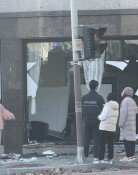New Law Standardizes Korean Addresses
New Law Standardizes Korean Addresses
Posted May. 19, 2006 03:05,
It will now be possible to find a given destination only by knowing the name of the road and the number of the building in Korea,
An electronic map handset showing new building and roads nationwide in real time will also eliminate the need for paper maps.
The Ministry of Government Administration and Home Affairs announced on May 18 that a law on road address and labeling procedures was passed by the Government Administration and Home Affairs Committee last month at the National Assembly, and will be submitted to the main assembly next month.
Address system to be changed-
According to the law stipulating the name of the road, the name should be distinguished by main street, side street, small road, and alley roads, and labeled in forms such as Gangnam-ro, Himang-ro and Jindallae-gil.
The buildings will be labeled with either an odd or even number according to the endpoint of each road.
For example, National Assembly, 1 Yeouido-dong, Yeongdeungpo-gu, Seoul will be changed to 48 Euisadang-ro Yeongdeungpo-gu, Seoul. The road name (Euisadang-ro) and building number (48) will enable people to find the National Assembly building.
In other countries, a road address system is already in use. Though the order may be different, all center on the name of the road.
In the U.S. and Great Britain, the sequence of the address is building number, road name, city name, state name, and postal code. In France the order is building number, road name, postal code, and city name; while in China, it is city name, district name, road name, and building number.
Address system from Japanese colonial era brings confusion-
Until late last year, the road labeling system in Korea, which started in 1997, has been completed at a rate of 43 percent in 101 cities among 234 cities, counties and districts nationwide.
But Koreas address labeling system still depends on the original land address method, while the road labeling system is still in flux.
Critics have claimed that though 165.5 billion won has been spent so far, no real progress has been made.
The land labeling system was a product of the land investigation project when the Japanese introduced a more modernized land policy during the colonial era.
The original address labeled in tong and ban does not have a consistent numbering system, and it does not label the address of shops or buildings, so it is hard to locate the address for visitors or in case of fire.
In order to establish a road labeling system that is up to international standards, the Ministry of Government Administration and Home Affairs plans to spend an additional 111.6 billion won through 2009.
Tae-Hun Hwang beetlez@donga.com



![[김순덕의 도발] ‘李부터 연임’ 개헌, 이 대통령은 가능성을 말했다](https://dimg.donga.com/c/138/175/90/1/wps/NEWS/IMAGE/2026/01/16/133172656.1.jpg)



